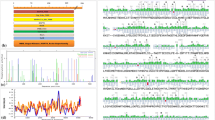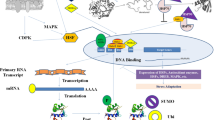Abstract
Heat stress causes an array of physiological, biochemical and morphological changes in plants, affecting growth and yield. Here, we report cloning of HSP90 gene of 2,323 bp from C-306 cultivar of wheat having ORF from 62 to 2,164 bp encoded for 700 amino acids. Quantitative real time expression analysis of HSP90 gene in C-306 showed 1.5, 1.2, 2.5 fold (in root), 4.5, 4.3 and 6.5 fold increase (in flag leaf) in the transcript level at pollination, milky dough and seed hardening stages. HSP90 transcript level was observed low in root as well as shoot of susceptible cultivar (PBW343) at different stages of growth. A significant difference in the fold expression of HSP90 was observed in C-306 and PBW343 against differential heat shock. An altered expression of H2O2 and decline in proline accumulation was observed in C-306 at different stages of growth. Western blot analysis revealed the presence of 5, 6 and 5 multiprotein chaperone complexes of HSP90 in the range of 95 Da to 70 KDa at pollination, milky dough and seed hardening stages. An expression of few novel isoenzymes of superoxide dismutase and catalase was observed against differential heat shock. A decrease in cell membrane stability was observed at different stages of growth in C-306 cultivar of wheat. In conclusion, we suggest that a high HSP90 transcript level along with high activities of antioxidant isoenzymes and low proline accumulation is a promising target for developing wheat genotypes with tolerance to heat stress.










Similar content being viewed by others
Abbreviations
- CAT:
-
Catalase
- SOD:
-
Superoxide dismutase
- HS:
-
Heat stress
- HSP:
-
Heat shock protein
- ROS:
-
Reactive oxygen species
References
Assad MT, Paulsen GM (2002) Genetic changes in resistance to environment stress by U.S. great Plains wheat cultivars. Euphytica 128:87–96
Bandurska H (1993) In vitro and In vivo effect of proline on nitrate reductase activity under osmotic stress in barley. Acta Physiol Plant 15:83–88
Bates LS, Waldren RP, Teare ID (1973) Rapid determination of free proline for water-stress studies. Plant Soil 39:205–207
Blum A, Ebercon A (1981) Cell membrane stability as a measure of drought and heat tolerance in wheat. Crop Sci J 21:43–47
Bohnert HJ, Jensen RG (1996) Strategies for engineering water-stress tolerance in plants. Trends Biotechnol 14:89–97
Bradford MM (1976) A rapid and sensitive method for the quantitation of microgram quantities of protein utilizing the principle of protein dye binding. Anal Biochem 72:248–254
Cheeseman JM (2006) Hydrogen peroxide concentrations in leaves under natural conditions. J Exp Bot 57:2435–2444
Chen S, Smith DF (1998) Hop as an adaptor in the heat shock protein 70 (Hsp70) and hsp90 chaperone machinery. J Biol Chem 273:35194–35200
Clement M, Leonhardt N, Droillard M, Reiter I, Montillet J, Genty B, Lauriere C, Nussaume L, Noel LD (2011) The cytosolic/nuclear HSC70 and HSP90 molecular chaperones are important for stomatal closure and modulate abscisic acid-dependent physiological responses in Arabidopsis. Plant Physiol. doi:10.1104/pp. 111.174425
Feder ME, Hoffman GE (1999) Heat-shock proteins, molecular chaperones, and the stress response: evolutionary and ecological physiology. Annu Rev Physiol 61:243–282
Fokar M, Blum A, Nguyen HT (1998) Heat tolerance in spring wheat. II. Grain filling. Euphytica 104:9–15
Hare PD, Cress WA (1997) Metabolic implications of stress-induced proline accumulation in plants. Plant Growth Regul 21:79–102
Hua X, Weitao LV, Lin B, Zhang M (2011) Proline accumulation is inhibitory to Arabidopsis seedlings during heat stress. Plant Physiol. doi:10.1104/pp. 111.175810
Kele Y, Oncel I (2002) Response of antioxidative defence system to temperature and water stress combinations in wheat seedlings. Plant Sci 163:783–790
Laemmli UK (1970) Cleavage of structural proteins during the assembly of the head of bacteriophage T4. Nature 227:680–685
Larkindale J, Knight MR (2002) Protection against heat stress-induced oxidative damage in Arabidopsis involves calcium, abscisic acid, ethylene, and salicylic acid. Plant Physiol 128:682–695
Loreto F, Velikova V (2001) Isoprene produced by leaves protects the photosynthetic apparatus against ozone damage, quenches ozone products, and reduces lipid peroxidation of cellular membranes. Plant Physiol 127:1781–1787
Mazhar H, Basha SM (2002) Effects of desiccation on peanut (Arachis hypogea L.) seed protein composition. Environ Exp Bot 47:67–75
Morita S, Kaminaka H, Masumura T, Tanaka K (1999) Induction of rice cytosolic ascorbate peroxidase mRNA by oxidative stress; the involvement of hydrogen peroxide in oxidative stress signaling. Plant Cell Physiol 40:417–422
Muessig C, Fischer S, Altmann T (2002) Brassinosteroid-regulated gene expression. Plant Physiol 129:1241–1251
Ozden M, Demirel U, Kahraman A (2009) Effects of proline on antioxidant system in leaves of grapevine (Vitis vinifera L.) exposed to oxidative stress by H2O2. Sci Hortic 119(2):163–168
Roychaudhari G, Sarath M, Zeece MJ (2003) Reversible denaturation of soyabean kunitz trypsin inhibitor. Arch Biochem Biophys 412:20–26
Roy SK, Hiyama T, Nakamoto H (1999) Purification and characterization of the 16-kDa heat-shock-responsive protein from the thermophilic cyanobacterium Synechococcus vulcanus, which is an α-crystallin-related, small heat shock protein. Eur J Biochem 262:406–416
Rucinska R, Waplak S, Gwozdz EA (1999) Free radical formation and activity of antioxidant enzymes in lupin roots exposed to lead. Plant Physiol Biochem 37:113–115
Rizhsky L, Liang H, Shuman J, Shulaev V, Davletova S, Mitler R (2004) When defense pathways collide: the response of Arabidopsis to a combination of drought and heat stress. Plant Physiol 134:1683–1696
Saadalla MM, Shanahan JF, Quick JS (1990) Heat tolerance in winter wheat: I. Hardening and genetic effects on membrane thermostability. Crop Sci 30:1243–1247
Sairam RK, Srivastava GC (2000) Induction of oxidative stress and antioxidant activity by hydrogen peroxide treatment in tolerant and susceptible wheat genotypes. Biol Plant 43:381–386
Schoffl F, Prandl R, Reindl A (1999) Regulation of the heat-shock response. Plant Physiol 117:1135–1137
Smith DF, Whitesell L, Nair SC, Chen S, Prapapanich V, Rimerman RA (1995) Progesterone receptor structure and function altered by geldanamycin, an hsp90-binding agent. Mol Cell Biol 15:6804–6812
Soliman WS, Fujimori M, Tase K, Sugiyama S (2011) Oxidative stress and physiological damage under prolonged heat stress in C3 grass Lolium perenne. Grassl Sci 57:101–106
Sung DY, Kaplan F, Lee KJ, Guy CL (2003) Acquired tolerance to temperature extremes. Trends Plant Sci 8:179–187
Vierling E (1991) The roles of heat shock proteins in plants. Annu Rev Plant Physiol Plant Mol Biol 42:579–620
Acknowledgments
The author sincerely thanks Indian Agricultural Research Institute (IARI) and Indian Council of Agriculture Research (ICAR) for financial assistance under National Initiative for Climate Resilient Agriculture (NICRA) project in order to take up the research work.
Author information
Authors and Affiliations
Corresponding author
Electronic supplementary material
Below is the link to the electronic supplementary material.
ESM Fig. 1
(PDF 197 kb)
ESM Fig. 2
(PDF 22 kb)
Rights and permissions
About this article
Cite this article
Kumar, R.R., Goswami, S., Sharma, S.K. et al. Differential expression of heat shock protein and alteration in osmolyte accumulation under heat stress in wheat. J. Plant Biochem. Biotechnol. 22, 16–26 (2013). https://doi.org/10.1007/s13562-012-0106-5
Received:
Accepted:
Published:
Issue Date:
DOI: https://doi.org/10.1007/s13562-012-0106-5




